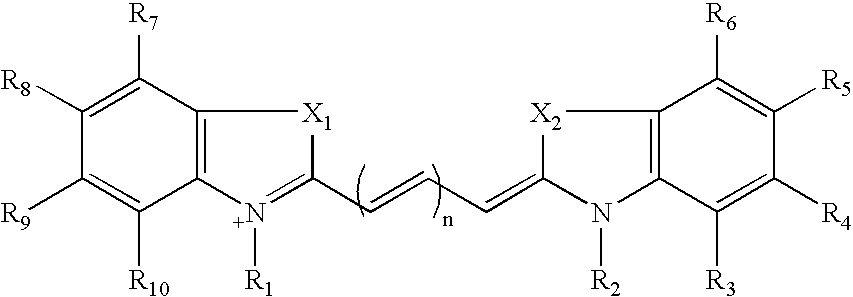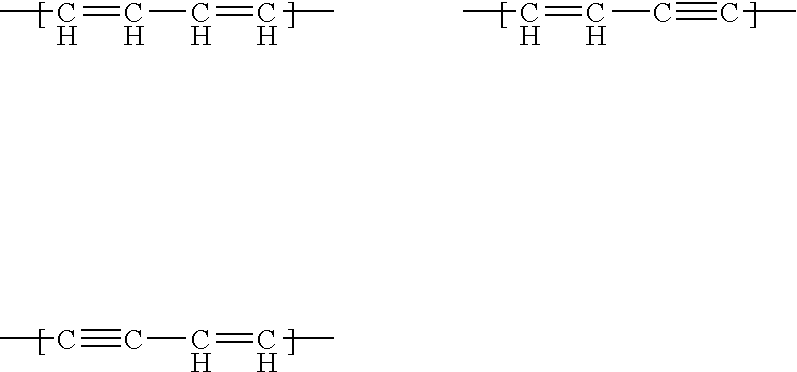Real-time nucleic acid detection processes and compositions
a nucleic acid detection and composition technology, applied in the field of nucleic acid technology, can solve the problems of bias often seen against the use of modified nucleotides, loss in the amount of nucleic acid synthesis compared to a reaction, and difficulty in incorporation
- Summary
- Abstract
- Description
- Claims
- Application Information
AI Technical Summary
Benefits of technology
Problems solved by technology
Method used
Image
Examples
example 1
Preparation of Cy 3 Labeling Reagent
[0240] (a) Preparation of Compound I (2,3,3-Trimethylindolinium 5-Sulfone)
[0241] P-Hydrazinobenzenesulfonic acid (250 g) was mixed with glacial acetic acid (750 ml) and 3-methyl-2-butanone (420 ml) and heated at reflux for 3 hr. The solution was poured into a 2 L beaker and allowed to cool overnight. The resultant suspension was filtered, washed with acetic acid and lyophylized to remove residual acetic acid. The resultant solid was dissolved in methanol (1.5 L) and a saturated solution of potassium hydroxide in 2-propanol (900 ml) was slowly added. The color of the solution turned progressively lighter as the potassium salt of 2,3,3-trimethylindolinium 5-sulfone precipitated. The precipitate was filtered by suction, washed with 2-propanol and lyophilized to dryness to give 238 g of Compound I.
[0242] (b) Preparation of Compound II (1-Ethyl-2,3,3-Trimethylindolenineninium 5-Sulfone)
[0243] A portion (78 g) of Compound I synthesized in step (a) w...
example 2
Preparation of Cy 5 Labeling Reagent (Compound VI)
[0250] Compound II (8 g) from step (b) of Example 1 and malonyl aldehyde dianil hydrochloride (10 g) were dissolved in 100 ml of a 1:1 mixture of glacial acetic acid and acetic anhydride followed by heating at 110° C. for two hours. The mixture was slowly poured into 500 ml of a 1:1 mixture of ethylacetate / ether and the precipitate was filtered, washed with a 1:1 mixture of ethylacetate / ether and dried by argon as above. The precipitate was then slowly added to a mixture of 12 g of Compound IV dissolved in 150 ml of a 1:1 mixture of pyridine / acetic anhydride while stirring. The mixture was transferred to an oil bath maintained at 90-100° C. for 30 minutes while continuing to stir. If desired, this step could have been extended up to 90 minutes. The reaction mixture was then cooled to room temperature and the precipitate was processed further as described previously for the Cy 3 labeling reagent in Example 1.
example 3
Attachment of Cy 3 (Compound V) to dUTP
[0251] Mercurated dUTP (30 umoles) prepared as described in U.S. Pat. No. 5,449,767 was dissolved in 1 ml of 1M Lithium acetate and the Cy 3 labeling reagent (60 umol, 0.6 ml) prepared in Example 1 (Compound V) was added with stirring. Potassium tetrachloropaladate (30 umol in 0.5 ml H2O) was added under argon. The reaction was monitored by HPLC and was complete after 1 hr at 40° C. Overnight incubation did not increase the yields. Four volumes of acetone were added to the reaction mixture and left overnight at −20° C. The next day, the precipitate was collected by centrifugation.
[0252] The pellet was dissolved in 0.1M Lithium acetate (pH 4) and loaded onto a DEAE Sephadex A25 column. The column was developed by passing through a linear gradient of 0.1-0.7 M LiCl in 0.1M Lithium acetate. The fractions were examined by HPLC and the fractions which contained a single late peak were collected and set aside. Another group of fractions exhibited t...
PUM
| Property | Measurement | Unit |
|---|---|---|
| wavelength | aaaaa | aaaaa |
| pH | aaaaa | aaaaa |
| single wavelength | aaaaa | aaaaa |
Abstract
Description
Claims
Application Information
 Login to View More
Login to View More - R&D
- Intellectual Property
- Life Sciences
- Materials
- Tech Scout
- Unparalleled Data Quality
- Higher Quality Content
- 60% Fewer Hallucinations
Browse by: Latest US Patents, China's latest patents, Technical Efficacy Thesaurus, Application Domain, Technology Topic, Popular Technical Reports.
© 2025 PatSnap. All rights reserved.Legal|Privacy policy|Modern Slavery Act Transparency Statement|Sitemap|About US| Contact US: help@patsnap.com



